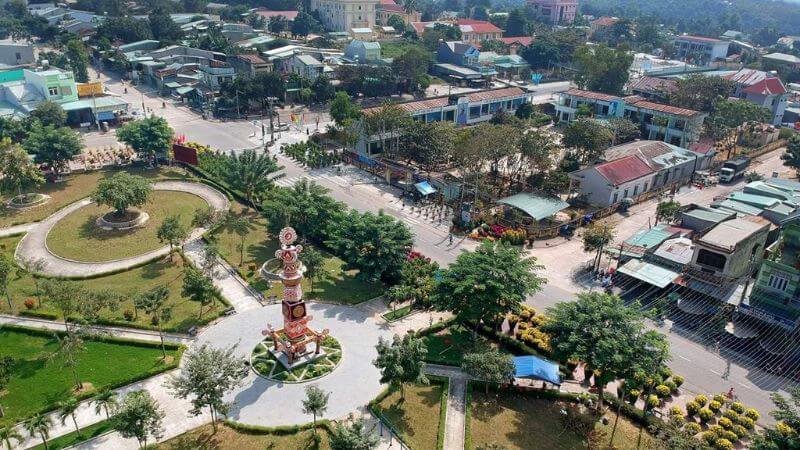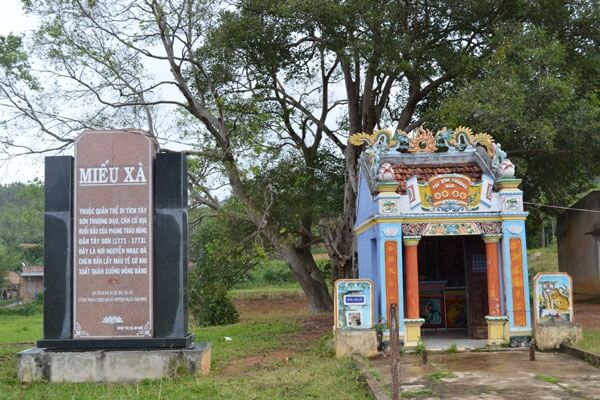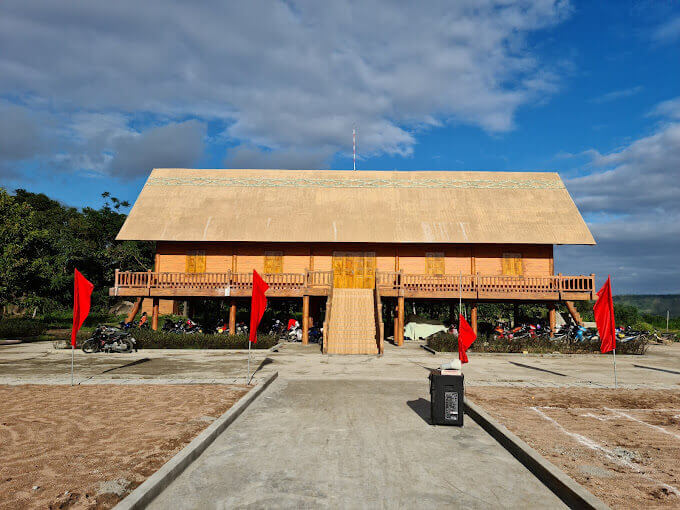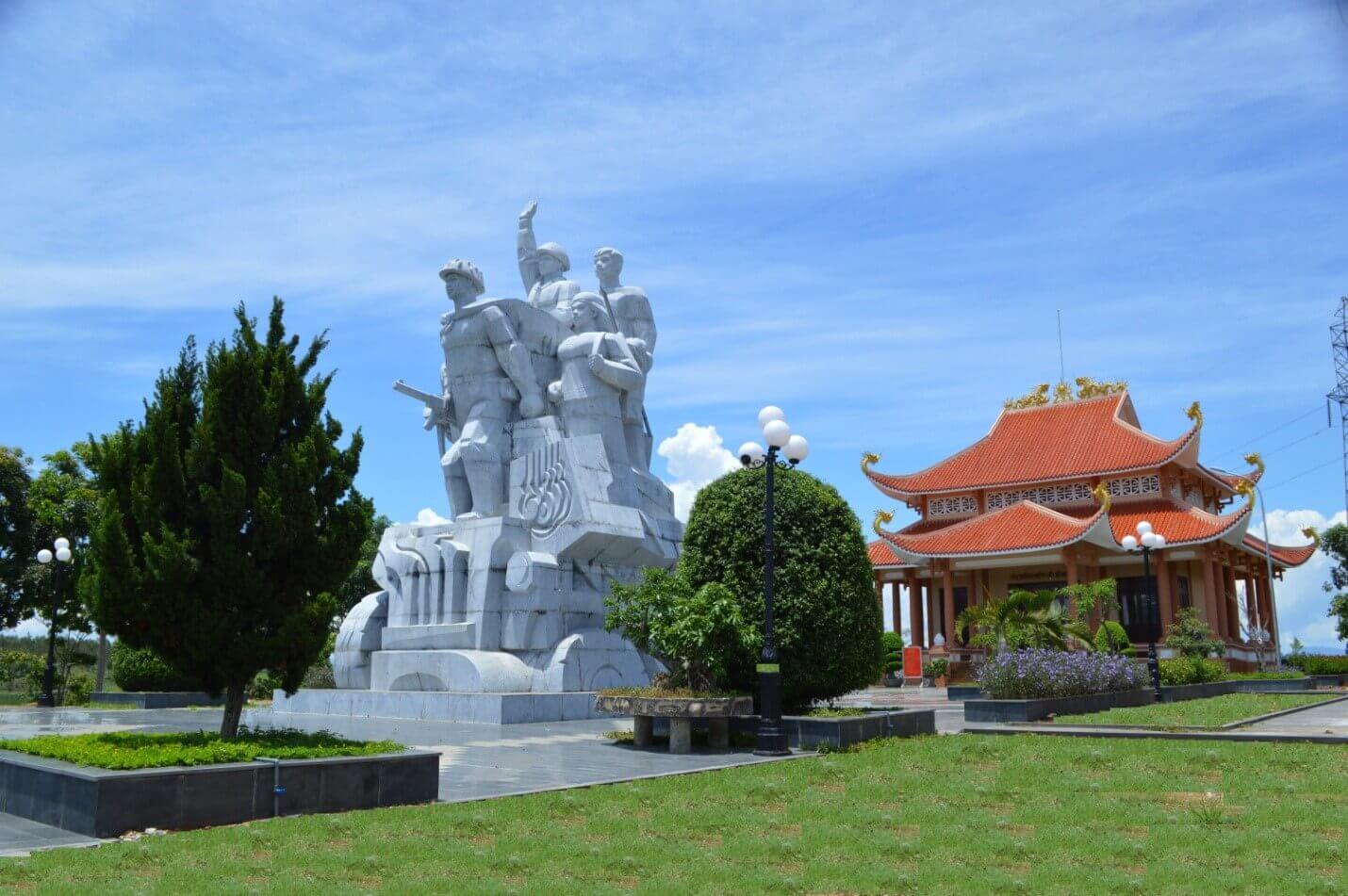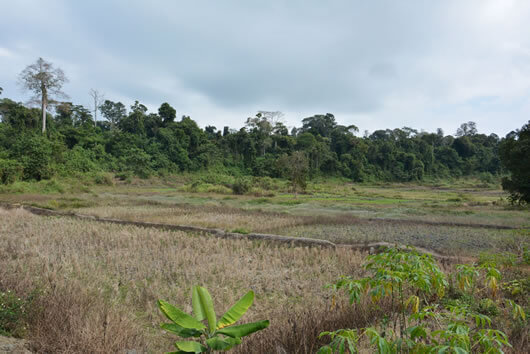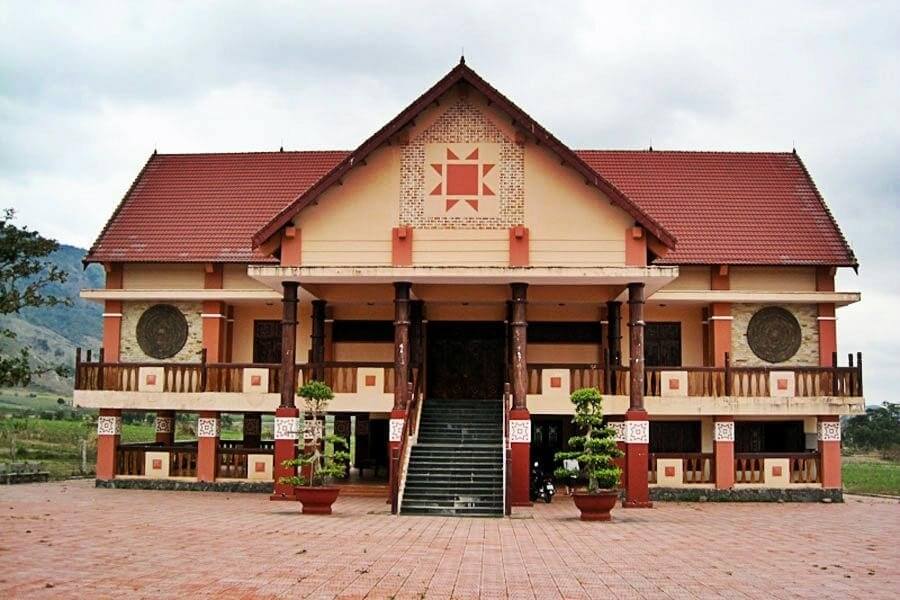Relic point Vietnam
Việt NamVictory location Route 7 - Song Bo
The legendary victory on Route 7 - Song Bo in March 1975 is always the pride of the Party Committee and every person living in Ayun Pa town and neighboring districts of Phu Thien, Ia Pa, Krong Pa, Gia province. Lai. This is where the largest pursuit of the enemy in the history of the Indochina war took place, led by our 320th Division in coordination with the local troops of Gia Lai and Dak Lak to crush the withdrawal of troops from the Central Highlands. of the puppet 2nd Army Corps, causing the enemy to fall into disastrous defeat; Marked the end of the Central Highlands Campaign in the spring of 1975 - the opening campaign for the General Offensive to completely liberate the South and unify the country. On March 4, 1975, the Central Highlands campaign opened, with a solid battlefield formation. In the following days, the entire Central Highlands was jubilant in the atmosphere of our soldiers liberating Buon Ma Thuot. With this victory, the Central Highlands campaign ended, the US-Puppet strategic position in South Vietnam was broken in a crucial area; The coastal areas of the Central region, the Southeast, and Saigon are threatened. With the victory in the Central Highlands, the revolutionary war of our army and people entered a new period: from an offensive of strategic significance, developing into a general offensive of strategic significance throughout the South, causing resulting in a historic victory in the spring of 1975. And, with the victory of Route 7 - Bo River, according to our records (and the enemy's recognition) - this was the decisive blow that made the strategic retreat plan of Major General, Commander of the 2nd Puppet Corps - Pham Van Phu was completely bankrupt. Bo River Bridge and Cay Sung Bridge became the enemy's terror. Also here appeared the heroic fighting example of Hero of the People's Armed Forces Nguyen Vi Hoi, who single-handedly shot down 6 enemy tanks, destroyed 21 enemies, contributing to writing the epic poem Route 7. After the country's liberation, Road 7 was renamed National Highway 25, becoming a vital traffic route connecting the Central Highlands and Central Highlands provinces. The historical relic of Victory on Road 7 - Song Bo is located on Highway 25, which is the contiguous area between Song Bo ward and Ia Sao commune (Ayun Pa town). On December 28, 2001, this location, along with the 7 River Bo Road Victory, was recognized by the Ministry of Culture and Information as a national historical relic. According to the minutes regulating the protection area of the Victory Road 7 - Bo River relic made by the Provincial Museum on August 11, 1998, the relic area has an area of 15,396 m2, located southeast of the Bo River bridge. , the East borders Hoang village (Ia Sao commune), the West borders National Highway 25, the South borders National Highway 25, the North borders Bo River. This is considered a red address for historical and traditional education for future generations. Source: Gia Lai Electronic Newspaper
Gia Lai 4028 view
Xa Temple
Xa Temple (Thuong An 2 village, Song An commune, An Khe town) belongs to Tay Son Thuong Dao Special National Monument Complex. Through many historical changes, the temple with many thrilling legends is still preserved by the people. Every year, on holidays and Tet, people in the area hold offerings to pray for gods to bless them with a peaceful, prosperous, and happy life. In the middle of a large plot of land, the Snake Temple is nestled under a row of ancient trees. On the left of the temple, there is a stele inscribed: Xa Temple belongs to the Tay Son Thuong Dao relic complex, the early base of the Tay Son peasant movement (1771-1773); This is where Nguyen Nhac cut a snake to take blood to sacrifice to the flag when sending his troops to the plain. Over the past 250 years, people in the Tay Son Thuong region have still passed down many thrilling stories related to Mieu Xa, the snake god. Legend has it that after a period of preparing strong soldiers and generals in Tay Son Thuong, in the year of the Snake (1773), the three Tay Son brothers (Nguyen Nhac, Nguyen Hue, Nguyen Lu) marched down to the plain. The army reached the beginning of Mang Pass (An Khe Pass), when a very large snake jumped from a tree to block the road. Among the generals, there were people who thought this was a bad omen and suggested withdrawing troops. Nguyen Nhac determined not to retreat but to move forward, draw his sword, cut off the snake's head, and use his blood to sacrifice to the flag. Down in the plain, the insurgents surrounded and defeated Quy Nhon citadel. After this victory, Nguyen Nhac had his soldiers build a temple to worship the snake god at the top of Mang pass. Contrary to the snake-slaying anecdote, folklore also holds that in 1773, Nguyen Hue commanded an army from the Upper Path to the Lower Path. At the beginning of An Khe pass, I saw a pair of ebony snakes lying in the middle of the road. Seeing that, Nguyen Hue immediately got off his horse and clasped his hands in prayer. As soon as his prayer ended, two snakes raised their heads and slithered forward. After walking a while, a snake crawled into the bushes along the road. When it came back, it held a dragon sword in its mouth and gave it to Nguyen Hue. Whenever going into battle, King Quang Trung-Nguyen Hue often used dragon swords to fight the enemy, winning many famous victories such as Rach Gam-Xoai Mut, Ngoc Hoi-Dong Da. To commemorate the snake god's gratitude, the king ordered people to build a temple at the top of Mang pass. In the past, the Snake Temple was built of bamboo leaves, surrounded by old forests. In 1957, people held a ceremony to ask the snake god for permission to move the temple to its current location to facilitate care and incense. “During the years of resistance against the French colonialists and American imperialists, many times, Mieu Xa was burned down by the enemy. But later, people immediately rebuilt it to have a place to worship the snake god. On February 20 and August 20 of the lunar calendar, people in the area and the Temple Management Board organize offerings to Quy Spring and Quy Thu according to traditional rituals; Every month, worship on the full moon and the first day of the year to pray for favorable weather, good crops, prosperous people's lives, and the local socio-economic development. Source: Gia Lai Electronic Newspaper
Gia Lai 4113 view
Plei Oi national historical and cultural relic
Plei Oi Historical-Cultural Relic Area is located in Plei Oi village - Ayun Ha commune, recognized as a National Historical-Cultural Relic in 1993. The place preserves many cultural values, including "Ceremony". Yang Potao Apui's rain prayer" was recognized by the Ministry of Culture, Sports and Tourism as a national intangible cultural heritage on June 8, 2015. This place also preserves almost intact artifacts such as: Magic sword, Oi Tu gong set, Chu Tao Yang mountain; Potao APuih tomb area, ancient Jrai people's house area, water wharf area... According to the Jrai people's concept, when humans are born, all things appear, at this time there is a god who gives water particles to bring life. for all things it is the God of rain. The god brings luck and happiness to people. In Jrai legend, there are 14 generations; The fire king "Potao Apui" used his magic sword to pray for rain when he was in the planting season or in the middle of the farming cycle and encountered drought or crop failure. Therefore, every year, Jrai people conduct a rain-praying ceremony to pray for heaven and earth to grant good rain and wind, good crops, a prosperous life for the people, and everyone to be safe and healthy. Here, visitors will experience the sacred and mysterious festival space; witnessed the Potao Apui (Fire King) using magic swords to pray for rain when the harvest season was about to begin or in the middle of the farming cycle but encountered drought and crop failure; In the minds of the Jrai people, if they displease the gods, they will not be given rainwater, causing illness and constant hunger and cold. In addition, special art programs are being urgently practiced by units and people with the desire to offer visitors elaborate, attractive and interesting performances such as: Gong dancing of local Jarai people; Directly participate in dances to invite wine, dance from the Northwest girls, traditional throwing game of the Tay ethnic group... Coming to Ayun Ha Irrigation Lake Ecotourism Area, visitors will admire the largest irrigation project in the Central Highlands, located in Thanh Thuong A village, Ayun Ha commune, at the foot of Chu Se pass, far from Highway 25. 1 kilometer. With an area of nearly 40 km2, the total irrigation water flow is 253 million cubic meters, providing abundant water resources in Phu Thien district and surrounding areas. There, visitors will enjoy the vast, rich space of hills, mountains, young water, charming and intimate, and visit the Ayun Ha Hydroelectric Plant with its green, peaceful campus. In addition, the lake surface is also a place to organize canoe and boat activities to serve visitors. Besides. Quang Son Pagoda is located in Thanh Thuong A village, Ayun Ha commune, 8 km west of the district administrative center, led by nun Thich Nu Nguyen Nhut, Quang Son pagoda is located at the foot of the mountain surrounded by green forests. Along with the Ayun Ha main canal system, it creates a solid fulcrum for charming mountains and water, meeting the religious needs of people from everywhere. Source: People's Committee of Ayun Ha commune - Phu Thien district - Gia Lai province
Gia Lai 4847 view
Dak Po Victory Memorial Stele
Dak Po - a famous place, a historical relic recording the resounding victory of the army and people of Dak Po in our nation's great resistance war to defend the country, here on June 24, 1954, the battle took place. launched an ambush to destroy the entire Mobile Army 100 (abbreviated as GIM 100), the strongest type of the French expeditionary force in Indochina. The Dak Po victory contributed to defeating the French Attland campaign. The Dak Po victory is one of the exemplary victories of intelligence and heroism in defeating the enemy. 64 years ago, on June 24, 1954, the main force Regiment 96 of Inter-Region 5 coordinated with Company 78 of Regiment 120 and local guerrilla militia to organize an ambush on Route 19, defeating the enemy. The 100th Mobile Army of the French colonialists is on its way to retreat from An Khe to Pleiku. The battle on Route 19 in Dak Po territory only lasted 7 hours, our troops took control of the battlefield, the enemy's 100th Mobile Army was completely destroyed. Our troops destroyed 500 enemies, wounded 600, captured 800 alive (including Nam Barroux - Commander of GIM 100) and captured all of the enemy's advanced weapons and vehicles. including: 375 motor vehicles (including 1 tank and 229 brand new vehicles), 18 105mm cannons and many other weapons, military equipment, military supplies and ammunition. The enemy's 100th Mobile Army was destroyed, our troops wiped out the entire enemy base system on Route 19, took over Tan An special zone, liberated the entire An Khe district (now An Khe town). and Dak Po district) and the eastern area of Pleiku town (now Pleiku city). With the Dak Po victory, the 96th Regiment successfully completed its mission, destroying the entire European and African Mobile Army GIM 100 of the French colonialists and enemy forces in the An Khe sub-region. The Dak Po victory created a sudden turning point, directly causing the enemy army in the Central Highlands to be defeated, giving the French army a heavy defeat, making an important contribution to Dien Bien Phu, and also to the French army. The country completely defeated the enemy's will to invade, forcing them to quickly sign an armistice agreement and soon restore peace throughout Indochina. Therefore, the Dak Po victory is considered "The Dien Bien Phu Victory of Inter-Region 5". However, to achieve this glorious victory, 147 officers and soldiers of the 96th Regiment and youth volunteers, militia and guerrillas of our units sacrificed heroically, but up to now their remains have not been found. . Dak Po will forever be one of the glorious victories of our army and people in the resistance war against the French. After this victory, President Ho Chi Minh sent a letter of praise: "The activities have had quite good achievements. Please, on behalf of the Government, praise you and reward the group that just won well at An Khe - the first-class Resistance Medal...". The Dak Po victory is forever the pride of the army and people of all ethnic groups in Zone 5 in the cause of national liberation struggle under the leadership of the Party and the great Uncle Ho. This is also a memorable lesson for all invading forces, a warning to the dark plans of invading forces that are about to set foot on this heroic land. In order to honor and commemorate the great merits and sacrifices of officers and soldiers of the 96th Regiment and local units, in 1998, the Ministry of Labor, War Invalids and Social Affairs and Gia Lai province built The Dak Po Victory Memorial Stele House was later recognized as a national historical relic by the Ministry of Culture, Sports and Tourism on December 28, 2001 on the ranking of relics and the Certificate of recognition as a historical relic. History - Culture. Source: Dak Po district electronic information portal
Gia Lai 4009 view
Jackfruit garden, Co Hau field
"Jackfruit Garden, Co Hau Field" belongs to the Tay Son Thuong Dao complex, the early base of the Tay Son movement, now in Nghia An commune, Kbang district, Gia Lai province. "Jackfruit Garden, Co Hau Field" is where Ya Do, also known as Co Hau - daughter of a Bahnar chief, wife of Nguyen Nhac, who had the merit of building the logistics force for the Tay Son army in the years beginning of the uprising. She and her compatriots in the area and the insurgents explored a 20-hectare area of land at the foot of Ca Nong mountain (now in Nghia An commune) to grow rice and food crops. In addition, she also planted a jackfruit garden to create more food sources for the insurgents. The fruits of "Jackfruit Garden, Co Hau Field" are a great contribution of Ya Do and the Bahnar people to the Tay Son movement. The memorial stele memorializing Ya Do's gratitude is located on an open plot of land. The stele engraves the merits of Ya Do and the people of Bahnar. The relic was recognized as a national historical relic by the Ministry of Culture, Information, Sports and Tourism in 1991. Right next to the memorial stele house is the green rice field where she and her compatriots reclaimed land in the past. growing food crops, lovingly called "Co Hau's Field" by later generations. Today, households still receive land to grow rice here, keeping the original appearance of the fields. The ancient jackfruit trees are dozens of meters tall, with lush foliage shading the entire forest. Their trunks are as big as a person's arm and have knobby knobs. These jackfruit trees are labeled with names to help people be aware of protecting the monument. The jackfruits are only as big as a kettle and have a crooked waist. Jackfruit is ripening on a tree trunk that has turned brown. In the past, these jackfruit trees were a source of food to provide additional nutrition for the Tay Son insurgents. When Ya Do passed away, her remains were buried at Dat Mountain (Cuu An, An Khe), now in An Dien Bac village right next to her house. After that, An Dien people built a palace to worship her made of wood and thatched. In the 19th century, people rebuilt the palace with bricks, lime, and mortar to worship her. Source: Gia Lai Museum
Gia Lai 4850 view
Hero Nup Memorial House
Hero Nup Memorial House - Stor resistance village is a typical historical and cultural relic of Kbang district, Gia Lai - a land rich in revolutionary tradition. Evidence on this land includes many provincial and national historical relics. One of them and the most typical is Stor resistance village relic - Hidden Heroes Memorial House. Hero Hiding as a leading bird of the revolutionary movement, fighting against the enemy to save the villages and country of ethnic minorities in the Central Highlands. The Hidden Hero Museum, also known as the Hidden Hero Memorial House, was built in 2010 and inaugurated on May 6, 2011, this is also the pride of the people of the Central Highlands. The museum is like a big house located in Stor village, To Tung commune, Kbang district, Gia Lai province. The Stor Resistance Village relic has become a symbol of the Central Highlands peoples, a symbol of courage, resilience and passionate patriotism. This is a place not to be missed when coming to this place, visitors come to commemorate the national hero who devoted himself to the great resistance. This relic was built on an area of 5 hectares, the combination of tradition and modernity creates a unique character for this place. The large gate opens to welcome visitors. When coming to the relic site, visitors will also be warmly welcomed by the people of Stor village with friendly smiles. If possible, they can also enjoy traditional festivals of the Bahnar people and feel the dances. sinuses, Gong sounds of the villagers and rustic dishes but it has become a specialty of the village. Stepping inside, you will see the memorial area and statue of Hero Nup and on both sides display many artifacts, images, precious documents about the life and career of Hero Nup along with many documents. records about the resistance village of Stor. Inside there is a model room simulating the resistance war against the French colonialists of his villagers. His real name is: Dinh Nup was born in 1914 and died in 1999 in Stor village of the Bahnar ethnic group. He was the leader of the people of Stor village to stand up against the enemy. Pictures and memorabilia of his life show the glorious victories and simple life of the national hero. Hero Nup Memorial House is a place to store valuable artifacts, over 400 pictures, documents, memorabilia of Hero Nup and many typical cultural artifacts of the Bahnar people. The simple and simple yet heroic and resilient beauty has created a special attraction for tourists. The environment here is fresh, the people's daily life is still very traditional, the people here are extremely open and friendly to everyone and visitors from other places will leave us with an unforgettable impression. . Source: Gia Lai Museum
Gia Lai 4395 view
Tay Son Thuong Dao Historical Relic Area
Tay Son Thuong Dao is the common name of the land located above the An Khe pass area, now belonging to An Khe town, Kong Chro district, Dak Po district and K'Bang district, called Tay Son Thuong Dao. to distinguish it from the lower Tay Son district, Tay Son district of Binh Dinh province. The Tay Son Thuong Dao relic complex currently includes 17 relics divided into 6 clusters distributed mainly in An Khe, and partly in Dak Po, Kong Chro, and Kbang. This complex was officially ranked as a national historical relic by the Ministry of Culture, Sports and Tourism in 1991 and will continue to be ranked as a special national historical relic in 2021. An Khe town is the main area of the Tay Son Thuong Dao relic complex where Tam Kiet (the three Nguyen brothers) chose to be the base to launch the legendary Tay Son movement. This is a place where, thanks to the rugged terrain, the vast mountainous forests and protected Ba River, this place also has very rich sources of forest products and land, suitable for raising soldiers and expanding the force. Food and grain storage during the early period of the uprising was also the starting point for the glorious historical journey of the Tay Son Dynasty. The entrance area is a large gate with two rows of monolithic stones and Bahnar gongs bearing the breath of Central Highlands culture. The gate area is also decorated with embossed reliefs of the Tay Son uprising such as people riding elephants, scenes of communal houses, scenes of carrying goods to battle, rivers, streams, and hills. The delicately crafted images express joy, steadfastness and confidence in the cloth-clad heroic leader, and belief in victory. Passing through the gate, visitors will see two rows of stone horses sculpted full of courage and pride with extremely prominent white color. The horses are sculpted in a galloping position towards the gate, with elegant and heroic lines. Entering the center of the Tay Son Thuong Dao relic area, visitors will see the Tay Son Tam Kiet communal house, the Tay Son Thuong Dao museum and An Khe Truong. Tay Son Tam Kiet Temple has ancient architecture with traditional tiled roofs, columns carved with ancient embossed motifs, in front of the temple is a very large painted pond surrounded by gray stone pillars creating a unique landscape. harmonious accent. Meanwhile, Tay Son Thuong Dao Museum is a place to store and display artifacts and pictures about the uprising. Coming to the Tay Son Thuong Dao historical relic site on the 4th and 5th days of the Lunar New Year every year, visitors will participate in the Hue Bridge Festival to commemorate the Tay Son uprising. The festival consists of two main parts: the ceremony with solemn rituals according to ancient customs to pray for good weather and peace, the country and people are safe, and the festival part is traditional cultural activities such as performing Tay Son traditional martial arts, performing arts. gongs, ring fighting, playing folk games... The scale of the Hue Bridge festival is very large, demonstrating unique culture and preserving traditional cultural beauty, contributing to promoting the historical value as well as promoting tourism of the Tay Son Thuong Dao relic area. Over hundreds of years, the relic still stands the test of time as a reminder of the roots and heroic past of our ancestors so that the next generations can build a more prosperous and beautiful homeland. Source: Gia Lai Tourism
Gia Lai 6951 view
Pleiku prison
Pleiku Lao House is located on a high red soil hill, Thong Nhat Street, Dien Hong Ward, Pleiku City, Gia Lai Province. The prison was built by the French from 1925 to 1941 and was solidly repaired. The total area of the prison area is about 7 hectares, surrounded by solid 3m high walls with layers of barbed wire fencing. In the northwest and southwest corners, there are two guard posts with armed soldiers on duty 24/7. In the east, there is a guard bunker. During the early period from 1925 to 1945, Pleiku prison was the place where France imprisoned patriots and some communist party members active in the Bau Can and Bien Ho Red Relief Associations such as: Phan Luong, Nguyen Ba Hoe, Tran Ren, Lam Thi No. From June 1946 to 1954, France exiled prisoners of war and political prisoners through extreme torture and execution such as comrades Nguyen Dong, Nguyen Nho, Dao Lut, and Le Gioi. In June 1948, the prison cell was established, contacted the outside organization and established a commune cell, Bau Can plantation, and the prison cell formed a joint cell with comrade Ho Hoan as secretary. led the fight against harsh prison regimes, against beatings, limited hard labor, protected the personality of communists and organized prison escapes. In the years 1965-1968, the revolutionary movement developed strongly and widely throughout Gia Lai province and during the 1968 Tet Offensive, political prisoners of Pleiku prison united to attack the enemy by sabotaging the enemy. The prison escaped, but the enemy shot and killed 46 people and injured many others. After the Tet Offensive, at Pleiku prison, the enemy locked up 800 political prisoners, and at this time the harsh regime of prisoners was also strengthened; However, with faith in the victory of the revolution, the revolutionary soldiers imprisoned by the enemy here were not afraid of sacrifice and hardship, remained united, persevered, and did not surrender to the enemy. In July 1968, the prison Party Committee was established with comrade Nguyen Kim Ky as secretary, leading the fight against the enemy right in the prison. The brutal forms of torture, both physical and mental, by the enemy still could not subdue the will and indomitable spirit of the revolutionary soldiers. On the afternoon of March 15, 1975, political prisoners rebelled to liberate the prison, ending 50 years of control by the imperial prison regime. On December 12, 1994, Pleiku Prison was decided by the Ministry of Culture and Information to be recognized as a national historical relic. Pleiku prison is one of the "red addresses" to educate revolutionary traditions for the people, especially pupils and students. Many Party organizations and Youth Unions have chosen this place to organize activities, recruit party members, union members and meet and listen to former prisoners tell stories. This place has become a tourist attraction for domestic and foreign tourists every time they set foot in this land rich in revolutionary tradition. Source: National Museum of History
Gia Lai 4456 view
Tomb of Mai Xuan Thuong
Mai Xuan Thuong was the leader of the Can Vuong movement against the French at the end of the 19th century in Binh Dinh. Mai Xuan Thuong was born in the year of Canh Than, 1860, died in the year of the Pig, 1887, from Phu Lac village, Phu Phong district, Tuy Vien district, Binh Dinh province (now Phu Lac village, Binh Thanh commune, Tay Son district, Binh Dinh province). His father, Mai Xuan Tin, was the chief father in Cao Bang. His mother, Huynh Thi Nguyet, was the daughter of a noble family in the village. Mai Xuan Thuong is inherently intelligent and eager to learn. At the age of 18 (1878), he passed the Baccalaureate at Binh Dinh Examination School. At the age of 25 (1885), he passed the bachelor's exam. Responding to King Ham Nghi's Can Vuong edict, Mai Xuan Thuong returned to his hometown of Phu Lac, recruited insurgents, set up a base on Sung island to raise the Can Vuong flag against the French, then Mai Xuan Thuong brought his forces to join the army. The insurgent army was led by Dao Doan Dich and was appointed by Dao Doan Dich to the position of Military Salary Officer (in charge of food for the insurgent army). From then until 1887, the Can Vuong movement in Binh Dinh developed strongly and spread to Quang Ngai, Phu Yen... attracting tens of thousands of people from all walks of life to participate. On September 20, 1885, Dao Doan Dich died and assigned all his forces to Mai Xuan Thuong. He chose the Loc Dong mountain area (now in Binh Tuong commune, Tay Son district) as his headquarters and organized a flag worshiping ceremony, calling on scholars, literati, and people to join the movement to fight against the French. During that ceremony, insurgents from many regions in Binh Dinh province agreed to honor him as the Marshal leading the uprising and raised the slogan: "First to kill the left, later to attack the West". In early 1887, the French army under the command of Lieutenant Colonel Cherrean and the royal army led by Tran Ba Loc along with Minister Trira launched a major attack on the headquarters of the Can Vuong movement in Binh Dinh, the battle The fighting between the insurgent forces and the French enemy was extremely fierce, the fight was unequal, and in the end the insurgent force was pushed back. In March 1887, after a fierce battle in Bau Sau (An Nhon town, Binh Dinh province), Mai Xuan Thuong was seriously injured, the insurgents withdrew to Linh Dong secret area. On April 21, 1887, Tran Ba Loc surrounded and captured the Linh Dong secret base and captured a number of insurgents, including Mai Nguyen Soai's mother. On the night of April 30, 1887, Mai Xuan Thuong sent a suicide squad to break into Tran Ba Loc barracks, relieve the captured people, and he and a group of 50 subordinates crossed the mountain into Phu Yen and continued to resist. battle, but when she reached Phu Quy Pass (boundary between Binh Dinh and Phu Yen), she was captured by Tran Ba Loc's ambush and taken to be beheaded at Go Cham (East of Binh Dinh Citadel). The mausoleum of patriot Mai Xuan Thuong is located on a high hill of the Ngang mountain range (in Hoa Son village, Binh Tuong commune, Tay Son district, Binh Dinh province) about 50km northwest of Quy Nhon city; The mausoleum was built on a land area of 1988m2, inaugurated on January 22, 1961. Overall, the mausoleum is designed in the style of an ancient mausoleum, surrounded by low walls. The Lang gate (three gates) is made up of 4 square pillars, the top is tied in the style of a gourd and a vase, bearing the architectural appearance of a communal house or temple gate of the late 19th century. In the middle of the Mausoleum is Mai Xuan Thuong's tomb, rectangular in shape in the East - West direction; At the head of the grave is a stone stele engraved with an inscription recording the biography and career of Mai Xuan Thuong: The relic was ranked at the National level by the Ministry of Culture and Information on April 20, 1995. Source: People's Committee of Tay Son District, Binh Dinh Province
Gia Lai 9751 view
Go Lang historical site
Go Lang relic is located in Phu Lac village, Binh Thanh commune, Tay Son district, Binh Dinh province. Here, with the remaining vestiges of the garden and the old house floor, the hometown of Mrs. Nguyen Thi Dong, the mother of the three Tay Son masterpieces: Nguyen Nhac, Nguyen Hue and Nguyen Lu, outstanding leaders of the Tay Son peasant movement in the 18th century. The relic was ranked at the National level on November 16, 1988. Go Lang relic has many events related to the Tay Son three masterpieces in the early days of winning people's hearts and building the Tay Son uprising. These are legends and oral stories that local people often tell. for many generations despite the Nguyen Dynasty's revenge and devastating war... The story "Nguyen Nhac Vi Vuong". The story goes: "One late night, on the death anniversary at the house of Mr. and Mrs. Ho Phi Phuc - Nguyen Thi Dong in Go Lang, when everyone finished saying goodbye to each other and left, everyone was shocked to hear the sound of gongs and drums. emerging from the direction of Hon Sung, a solemn and mysterious sight that had never happened before. Everyone stopped and saw a magical light shining on an area on the mountain. They encouraged each other to go up and see. Arriving at the place of light, while hesitating and no one dared to advance, from the light suddenly appeared an old man with a red face, a long white beard, and a dragonfly hat. He stepped out and said loudly: among you. Is there anyone Nguyen Nhac? I obeyed the Jade Emperor's order to descend to the world this time to give the decree to King Nguyen Nhac. When Nguyen Nhac stepped forward, everyone bowed their heads respectfully and the old man disappeared. Or the story: Every time the Tay Son brothers return to their grandmother's hometown, they often tie their horses at the tall Bodhi tree next to Mr. and Mrs. Ho Phi Phuc's house, so the people in the area have a saying: "He's back on his horse again, Cutting Bodhi grass for his horses to eat." After the Tay Son dynasty passed away, the Nguyen Gia Long dynasty implemented a very harsh revenge policy. Mr. and Mrs. Ho Phi Phuc's old house at the relic was razed and became an empty piece of land, with only traces of the house's foundation remaining. , the square pillar stone is engraved with a rosette pattern with a size of 0.4m on each side and many ceramic fragments of broken dishes; In the old garden there are also some ancient trees: Thi, Thien Tue... During the Nguyen Dynasty, Phu Lac people always remembered and paid tribute to their ancestors and heroes of their homeland. They built a temple to worship Son Quan (Mountain God) called Cay Thi temple, some people called it Cay Thi temple. Mr. and Mrs. Ho Phi Phuc - Nguyen Thi Dong at their old garden and secretly worshiped Mr. and Mrs. Ho Phi Phuc - Nguyen Thi Dong, Tay Son Tam Kieu (Nguyen Nhac, Nguyen Hue and Nguyen Lu) on November 14, Lunar New Year The annual calendar at Phu Lac village communal house is called Thuong Tan worshiping day (new rice festival) with the form of commemorating flower incense and fox nectar. In 1999, the local government built a temple on the old foundation of the relic to worship Mr. and Mrs. Ho Phi Phuc - Nguyen Thi Dong and their paternal and maternal families, as well as ancestors who had publicly established the village, and the three masterpieces of Tay Son; Source: People's Committee of Tay Son District, Binh Dinh Province
Gia Lai 6886 view
